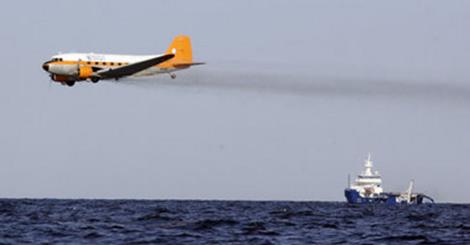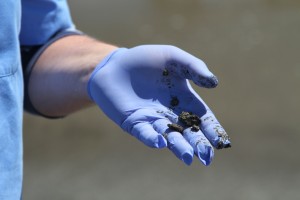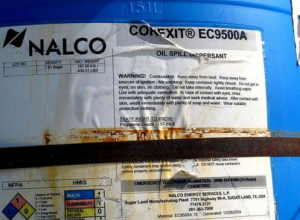
New Managing Director for Bellona Norway
The Board of the Bellona Foundation has appointed former Minister of Climate and the Environment Sveinung Rotevatn as Managing Director of Bellona No...
News

Publish date: June 9, 2015
Written by: Charles Digges
News
MOBILE, Alabama – An Alabama chemist is warning Gulf of Mexico residents that future hurricanes could bring Deepwater Horizon oil and dispersant inland via storm surges and heavy rains, and pose even bigger environmental threats and health risks than the initial spill in 2010.
“We’re waiting for the next big storm, and we don’t know when it will hit,” Robert Naman, head of Mobile’s Analytical Chemical Testing lab told a local gathering hosted by the Sierra Club last week. “We haven’t had a major storm since the 2010 BP oil spill, and when that next disaster hits, it will be worse than the initial spill.”
His statements reflect those of many scientists and environmentalists on the Gulf Coast who’ve been waiting for that shoe to drop.

Jonathan Henderson of the Gulf Restoration Network told Bellona that an Exxon Valdez volume of oil was spread throughout Louisiana waters as Hurricane Katrina hit pipelines, toppled storage tank batteries and well-heads August 2005.
While Henderson agrees that a hurricane could re-mobilize BP as happened during the small, category 1 Hurricane Issac in 2012, the larger problem is the sheer amount of oil platforms and pipelines in the Gulf that, should they leak or blowout during a storm, could be unreachable by first responders for weeks.
This is especially worrisome if one storm is followed closely by another, as when Rita followed Katrina in September 2005.
“We could have blowouts and pipeline ruptures that could happen in the next big storm,” Henderson told Bellona in a telephone interview. “Then, what if there is another storm that follows thereafter? My fear is that oil in this scenario could be pushed into the city of New Orleans.”
Hurricane season this year began on June 1 and runs through November 30.
Dr Samantha Joye, one of the most eminent marine biologists working on post BP studies of the Gulf says storms have had devastating effects on beaches.
And Henderson has been collecting Macondo tar balls after coastal rainstorms in Louisiana for five years, his most recent finds dating back only weeks.

A hurricane, said Naman, would churn up oil and the toxic dispersant Corexit on the sea bottom and in deposits on beaches, and pummel some 1300 kilometers of coastline, impacting around 20 million Gulf residents as the mixture pushes inland with rising seas and in torrential rains, causing land and air contamination.
“A hurricane would shower oily residues into people’s yards, houses, onto their clothes, and permeate both coastal and inland air,” he said. “We will see the oil again and again – no one has any clue as to what it will cost to continue cleaning it over the next 100 years, and more people are going to die.”
Deep deposits of oil that sank as deep as 3000 meters in canyons off the Alabama and Florida coasts could unleash their contents in the right current conditions.
What is still in the water?
Recent findings by the National Oceanic and Administration (NOAA) that BP spill is responsible for at least a thousand Dolphin deaths since 2010, and is today even killing crickets in Louisiana marshes that were heavily oiled, make Naman’s assertions all the more disquieting.
Linda Hooper Bui, the environmental scientist at Louisiana State University who ran the cricket study, says its difficult to tell what mix of pollutants is killing the insects.
“It’s this huge mystery,” she told the Student Science portal. She’s seeking to determine if whatever is still lingering in the marshes can kill insects and humans alike, a question she says “keeps me up at night.”
NOAA’s Dr. Teri Rowles, who led the Dolphin study, was more certain.

“These studies have increasingly pointed to the presence of petroleum hydrocarbons as being the most significant cause of the illnesses and deaths plaguing the Gulf’s dolphin population,” she said. “This study carries those findings significantly forward.”
Puzzling together remaining seabed oil
Naman and many others are concerned about oil that BP and federal agencies can’t account for. Other independent scientists have come up with some disturbing estimates.
According to newly release data publicized in Harper’s Magazine and Democracy Now, Dr. Joye says 30 million gallons have settled on the seafloor near the blown out Macondo wellhead.
Add to this at least another 10 million gallons determined to still be in the deep by David Valentine’s “bathtub ring” study by the University of California, Santa Barbara, and Jeffrey Chanton’s Florida State University study that revealed 10 million gallons more oil entrained in subsea sediments.
Central to studies conducted by Dr Joye, who used deep-diving Alvin submarines, is the discovery that seafloor microbial communities that were expected to bloom and metabolize sunken oil were deterred from doing so by the oil dispersant Corexit. The community was “nuked and killed,” and what remained was as much as six centimeters of oil covering the ocean floor she studied.
Dr Joye told Bellona in her earlier interview that her team had been observing the microbial community since before the spill, so had a baseline for comparison. The spill confounded her expectations of what would happen to the community when oil hit.
“The difference that is most perplexing to me is that this carbon fusion did not cause a huge microbial bloom on the seabed,” she said.
At present, according to Democracy Now, she said the cold anaerobic environment of the sea floor ensures the most toxic part of the oil and Corexit is now a permanent feature of the Gulf seabed – and it will continue to cause environmental harm.
Microbes prevented from doing their job
Dr Joye’s assessment squares with Naman’s theory that crude and Corexit, which is 52 times more toxic than oil alone, stymied microbial communities’ metabolism of Macondo oil, and in many cases killed them altogether.

These TICs, according to Naman’s studies, bear similarities to benzene, a known carcinogenic component of crude. But benzene has been studied, where other TICs that have formed in the Gulf have unknown toxicities. Naman told the gathering he and other scientists have recorded these compounds, but that federal testing criteria exclude them.
Many compounds Naman listed – like tetradecane, 2-pentanone and hexadeconic acid –Bellona’s adviser on petroleum pollution Karl Kristensen said are not dangerous in and of themselves.
It’s the other compounds to which they might bind, he said, that are cause for real worry.
“If New Orleans were to be sprayed with oil containing only these compounds, you should count yourself lucky, but that is very unlikely,” he said. “Any oil spill weathered or not will most likely contain many more compounds, including compounds with significantly higher eco-toxicity and health damage potential.”
Friction between science and community
Of the 50 attendees at the Sierra Club talk, most identified themselves as suffering from chronic illnesses from the spill.
Dr. George Crozier, who was the executive director of Alabama’s Dauphin Island Sea Lab during the Deepwater Horizon spill referenced scientific studies that said a hurricane wouldn’t churn up petroleum products lying so deep.
Many in the audience immediately accused Crozier of receiving a multi-million dollar grant from BP for his lab to turn out baked science, something he refuted in a later email interview with Bellona.
“The presentation and reactions at the Sierra Club meeting reflect the deep concerns by many people who have experienced the impacts of the Deepwater Horizon oil spill,” he wrote. “Unfortunately it also reveals a very poor understanding of scientific issues, deep distrust of government agencies, and an insulting belief that academic science has been perverted by big oil money.”
Crozier is on record in local press as denying BP contracted funding that became available immediately after the spill.
“It felt like they were trying to make sure we couldn’t testify against them. Basically, we told them where they could stick their contract,” Crozier was quoted by AL.com as saying.
Trisha Springstead, a Florida –based nurse who has studied the advance of spill related illnesses independently since the Deepwater Horizon exploded – says there is enormous friction between academia, federal agencies and scientific community on one side, and those who saw their livelihoods and health destroyed by the spill on the other.
“The issue is that people on the ground, people who have been affected by this spill in many cases know more than the scientists themselves,” she said. “My advice to the scientists is get out of your institutions and look at, listen to and feel what they have to show you.”

The Board of the Bellona Foundation has appointed former Minister of Climate and the Environment Sveinung Rotevatn as Managing Director of Bellona No...

Økokrim, Norway’s authority for investigating and prosecuting economic and environmental crime, has imposed a record fine on Equinor following a comp...

Our op-ed originally appeared in The Moscow Times. For more than three decades, Russia has been burdened with the remains of the Soviet ...

The United Nation’s COP30 global climate negotiations in Belém, Brazil ended this weekend with a watered-down resolution that failed to halt deforest...